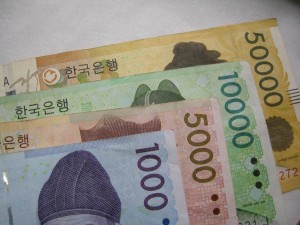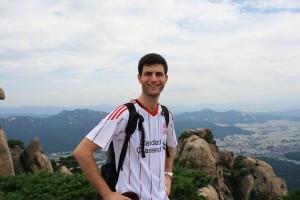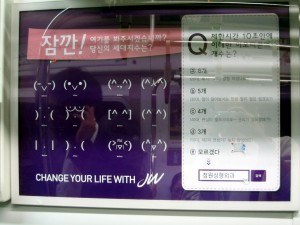You can read about the other “Strange Places I’ve Called Home” here.
In early spring 2007, I was at a strange place in my life. Nine months into my stay in Japan, and I was essentially told my services were no longer welcomed after my contract was up, and I was in a short-lived relationship with a girl I liked talking to, but not much else. I had a week away from my school, and no plans. Friday night I broke things off with the girl. Saturday morning I shaved my depression beard, picked up the Korea Lonely Planet at the train station, and jumped on a train to Fukuoka. And finally on Sunday morning I arrived in Busan, Korea via ferry. It took me approximately five minutes to fall in love with Korea.
I was stopped literally three times before leaving the port by friendly Koreans asking if I needed help in English. I can’t stress this last point enough, as hearing English in the streets of Japan was an extreme rarity. Then I saw a Dunkin Donuts selling bagels with cream cheese, and I wondered if I had died somewhere along the way and was now in heaven. When I saw Koreans jaywalking at the first intersection I approached, my suspicions had been confirmed: clearly these were either the fantasies of a dying brain, or heaven. The week went by fast, and at no point did I feel the need to reconsider my first impressions of the country. I felt free to be myself in Korea, and it was wonderful. I left the country thinking, “If I ever teach ESL again, I’m coming back here.”
Fast forward to the summer of 2010, and I was at yet another strange place in my life, this time struggling to maintain steady employment or do anything of note in my life since the onset of The Great Recession two years earlier. I didn’t quite know what I wanted out of life, but I knew working dead-end, part-time jobs whilst bouncing on and off of unemployment was not it.
For the first time in three years, the idea of going abroad to find steady employment and financial stability didn’t seem so far-fetched. When I subsequently found out that it would be easy to bring my dog along for the ride, I was sold; I was going back to Korea.
“Easy” is a subjective word. While the paperwork and fees to bring her to Korea were easy hurdles to clear, and my school directors thought it would be “no problem,” it was anything but when we arrived. The landlord flat-out refused to let us stay in his apartment, despite the fact that other dogs lived there. Now, my dog is in no way big, but Seoulites generally like their dogs small enough to fit in their purses. The landlord had a contract with my school for around ten of our teachers, and he couldn’t very well risk ruining the relationship with them over a dog, but he could yell at me about her literally every single time I came home.
I asked both our academic coordinator and vice director for advice. The latter told me “not to worry about it,” while the former suggested that I start bringing the landlord and doormen gifts of fruit. My previous experience in Asia told me that bribery was the best way to go, and so I set out bringing peaches, apples, and pears–all of which had been genetically modified to the size of a small child’s head–to the doorman and landlord every single day for about a month. Finally, it was enough, the doorman smiled and made a motion with his hands indicating that my bribery had been satisfactory.
Throughout the early months of my Korean adventure, I took solace in the knowledge that my sizable debts were being repaid, and the turbulent days of the last several years were finally settling down. The job wasn’t great. In fact, it was extremely stressful, with unreasonable hours, but at first, I didn’t mind. I was extremely thankful just to have steady employment, even if the monthly paycheck did come in the form of millions of Korean Won (pronounced as you would “wand” without the “d,” and abbreviated with the symbol: ₩).
 Although there are more inflated currencies out there, you’d be hard pressed to find a country with such a big economy matched to such a strange currency as Korea and its Won. In the last few years, the Won has been as strong as ₩950 to the U.S. dollar, and as weak as ₩1200 to $1, but it generally hangs out around ₩1050 to $1. The Won comes in ₩1000, ₩5000, ₩10000, and ₩50000 notes, although the highest denomination is exceedingly rare. After exchanging Japanese Yen for Won on my first trip to Korea, I wound up carrying a gangster’s role of Won. It might have not actually been worth a lot of money, but it felt substantial. Also, playing poker in the local casino instantly made me feel like an instant high-roller.
Although there are more inflated currencies out there, you’d be hard pressed to find a country with such a big economy matched to such a strange currency as Korea and its Won. In the last few years, the Won has been as strong as ₩950 to the U.S. dollar, and as weak as ₩1200 to $1, but it generally hangs out around ₩1050 to $1. The Won comes in ₩1000, ₩5000, ₩10000, and ₩50000 notes, although the highest denomination is exceedingly rare. After exchanging Japanese Yen for Won on my first trip to Korea, I wound up carrying a gangster’s role of Won. It might have not actually been worth a lot of money, but it felt substantial. Also, playing poker in the local casino instantly made me feel like an instant high-roller.
When I wasn’t slaving away at work, Seoul was a pretty exciting place to be. For one, it’s enormous. The city itself has about 12 million people, and the metropolitan area has over 20. When looking down from the mountain tops of some of Seoul’s favored hiking destinations, it looks like Sim City, with huge high-rise apartments as far as the eye can see. Also adding to the excitement, if you can call it that, is the fact that Seoul is precariously positioned about 35 miles from the Demilitarized Zone (DMZ, the de facto border), and the two Koreas are still technically at war. As such, almost every major thoroughfare is designed to become a makeshift landing strip, and every bridge crossing the Han River is wired with explosives, ready to blow in order to slow down any potential North Korean advance. Military strategists basically consider Seoul to be a “lost cause” in the case of a major offensive from the North, one that would have to be surrendered and then taken back with force. As I said, exciting.
For citizens living in a city under constant threat from one of the world’s most dangerous regimes, Seoulites get about their business without as much as a second thought of their crazy neighbor to the north. All of these people need to get around, and in my experience, no where does public transportation better than Seoul. The trains are fast, efficient, clean, and always run on time. The entire thing is electronic, with buses, trains, and taxis all using the same system, so transfers are free, and you only paid for what you need. The signs are large, well marked, and can be read in Korean, English, and Japanese. The maps even show travelers which train car and door they should use if they want the fastest possible exchange.
Even the buses in Seoul are a pleasure to ride. The destinations, as well as several major stops along the way, are clearly marked on the front and sides in Korean and English. And, they’re color-coded. Green buses run small, local routes. Blue buses are longer point-to-point buses within the city. Yellow buses run on a loop, also to major points around the city. And red buses are express buses, connecting the city to suburban destinations. In short, Nagasaki could learn a thing or two from Seoul.
However, the taxis, particularly the taxi drivers, could use some major improvements. The cars themselves are nice, new, and clean. They all come with GPS, which must be helpful for even the best drivers in a city of 20 million. But then there are the drivers. In my experience, the taxi drivers were either complete jerks, or complete idiots. Occasionally, they’d be both. When requesting a fare, the trip was often either “too long” or “too short” and they would flat-out refuse the fare. Or, the drivers would refuse because they were currently facing the wrong direction. Apparently turning around isn’t a thing that they had ever considered. And the drivers frequently got lost. Like, all the time. The cynical part of me wants to think that this was an elaborate ploy to get more money out of the fare, but after seeing their confused looks, ill-fated attempts to find the location on GPS, and frantic phone calls to the dispatch center, I believe their confusion to either be 100% genuine, or these drivers possess Academy Award-level acting skills. At least the taxis were cheap, and they generally got you where you wanted to go.
One important thing to understand about Korea is how recently their economy has taken off. Since 1990, the GDP per capita has risen from around $8000 to around $25,000. The Purchasing Power Parity (political scientist-speak for the cost of living as compared to income) has more than doubled since 1999, from $13,000 to over $33,000. This sudden influx of wealth has created some odd cultural features. Sure, you can now find the gleaming shopping malls and latest designer goods, and the Koreans go nuts for them. But, you can also find the traditional back-street markets, selling everything under the sun. Often, the markets and malls are right next to each other. You’ll turn down a wrong alley, or right, depending on your perspective, and suddenly you’re being shown goods by an overly enthusiastic older Korean man in a tank top and sandals.
Generally, I preferred the back-alley markets. The goods weren’t always the best, but the deals were great, and unlike many other traditional markets, you didn’t have to spend substantial time or effort negotiating a price. This is another under-appreciated aspect of Korean culture: they generally won’t rip you off, even if they have the chance. A great example of this are the prices inside baseball and soccer matches. You can buy a beer for about ₩3000 inside the stadium, and exactly that amount outside. In fact, you can even bring food with you, whether it be from the nearest KFC, or the old lady selling kimbap (what can best be described as Korean sushi) outside the gate.
It’s an interesting mixture of traditional Korean culture, and newly adopted Western culture. It’s not always for the best. Consumerism and extreme fashion-consciousness runs rampant through the streets of Seoul. Many Koreans, particularly the younger generation, associate wealth with Western designer clothes, plastic surgery (Korea has the most cosmetic operations per capita in the world), and coffee shops. Especially coffee shops. In America we joke about a “Starbucks on every corner,” but in Korea there’s not only a Starbucks on every corner, but also a Caffe Bene, Paris Baguette, Zoo Coffee, Angel-in-us Coffee, Tom N Toms Coffee, and about a million more. Any economist studying market saturation would do well to study South Korean Coffee Culture.
I’m not saying the coffee shops are a bad thing. Quite the opposite, they’re usually quite lovely. And, it helps fuel one of my favorite things about Koreans: their enthusiasm. Koreans take the saying “Work hard, play hard” to heart. They might work long hours, but when they have time to enjoy their favorite hobbies, whether it’s hiking or playing video games, they jump in with panache, very often with the best gear money can buy.
I would only remain in Seoul, officially, for about 10 months. My next move would take me to the edge of the civilized world, about 2 miles from the North Korean border, in Paju. Sure, I might have remained in the Seoul metropolitan area, but living at a fake castle overlooking North Korea surely deserves its own post.
“Strange Places” will resume soon with Part 6: Paju.




1 comment for “Part 5, Seoul”